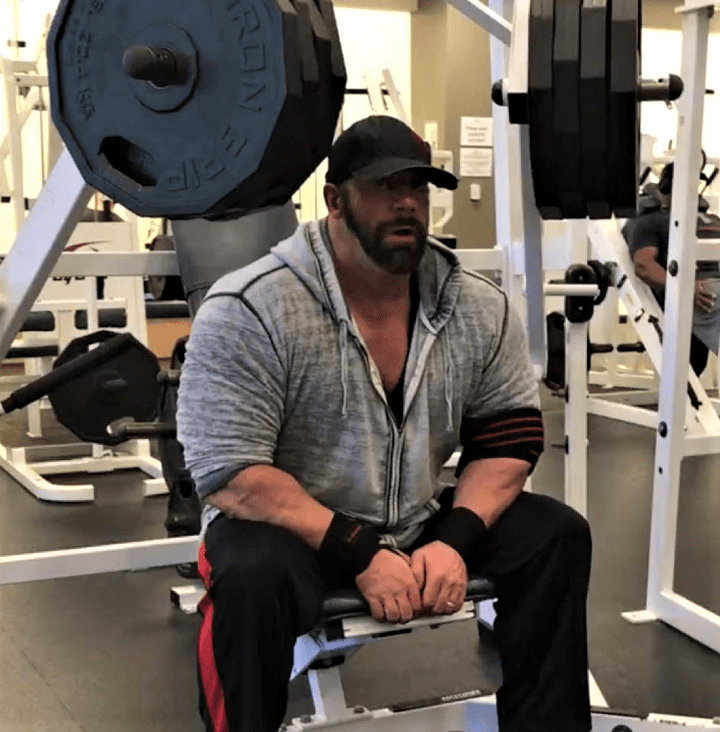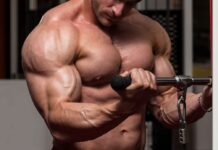Doggcrapp adherent David Henry grinds out chest dips. / Instagram video
Forget the name for minute. Doggcrapp is that rare thing—a revolutionary weight-training system. It started “underground” on an internet forum, and, though it’s never gone mainstream, it at least went bodybuilding-mainstream. I wrote about DC extensively in FLEX magazine around 15 years ago. Pro bodybuilders Cedric McMillan, David Henry, Steve Kuclo, and Mark Dugdale were among its many adherents. DC resurrected rest-pause, an invaluable but long-neglected technique; and it shifted emphasis away from volume and intensity to strength.
Doggcrapp is the most unique bodybuilding system since high-intensity training arrived 30 years before it. Even if you don’t strictly follow a Doggcrapp protocol, focusing on long-range strength gains for moderate-to-high reps in mostly compound exercises is a great muscle-making strategy. Let’s investigate Doggcrapp, how it works, and how getting stronger for reps and rotating your exercises can unleash continuous growth.
DOGGCRAPP: THE NAME
Okay, back to the name. When self-taught training and nutrition expert Dante Trudel, who published the newsletter Hardcore Muscle in the mid-’90s, posted his unique workout philosophy to an internet discussion board in 2000, he thought no more than the few dozen meatheads there would read it. That explains the moniker. “Doggcrapp” (with the superfluous “g” and “p”) was his spur-of-the-moment, what-the-hell screenname for what he anticipated would be a single post that would soon fade away. But Trudel was deluged with questions, the original post grew to 118 pages, and his musings were copied and pasted all around the internet, and they have been ever since.

Dante Trudel told me that if he knew Doggcrapp would become so popular, he would’ve chosen a cooler name. But Doggcrapp is certainly memorable, and most adherents refer to it as “DC” anyway. The name also seems oddly appropriate in a punk rock sort of way, because Doggcrapp is an anarchic ideology that challenges the status quo of same-old same-old training.
DOGGCRAPP: THE PHILOSOPHY
“I thought about what makes a muscle grow, what would make it grow faster, and to absolutely stop thinking in this I want to be big so bad I’ll overthink and overdo everything concept,” Dante Trudel told me in 2006. “Why do people think in terms of annihilating myself into rigor mortis in today’s workout instead of progression and recovery over weeks, months, and years? I scrapped everything and reverse-engineered it. I broke it down, took out all the things I felt were just fluff and there for ego and obsessive-compulsive satisfaction, and created a power-building attack.”
What Trudel deduced was that bodybuilding gains are directly related to strength gains. Forget pumping up the muscles or shocking them with intensity techniques. Doggcrapp prescribes that you choose only one exercise per body part (two for back) per workout and focus on growing progressively stronger in that exercise over time.
Of course, this is easier said than done. Try to beat your best in the same lift workout after workout, and you’ll quickly smash into a wall. Trudel knew this. To avoid that wall as long as possible, he devised a rotation for doing a different exercise for each body part from workout to workout.
Let’s break down the Doggcrapp fundamentals and exactly how a DC workout routine is assembled.
DOGGCRAPP: FUNDAMENTALS
◼️ Progressive strength gains are paramount to progressive size gains.
◼️ Do only one exercise per body part per workout with the exception of back, which is trained with one thickness exercise and one width exercise.
◼️ Do as many warm-up sets as necessary (typically 2-4 progressively heavier sets), but usually only one working set per exercise.
◼️ With the focus on one working set of one exercise per body part, you have the energy, strength, and time to hit several body parts in each workout.
◼️ Doggcrapp prescribes dividing your body into two workouts (A and B) and training three times per week, so each muscle is worked three times every two weeks (see schedule below).
◼️ You never do the same exercise for a body part that you did the workout before or the workout after. Instead, you rotate three workouts, each of which focuses on one different exercise per body part. So, the exercises you do in your first workouts (A1, B1) you repeat in your fourth workouts, two weeks later, and on and on (see schedule below)
◼️ Always endeavor to get at least one more rep with the same weight or the same reps with more weight than you got the last time you did that workout, two weeks before. If you fail to do this, remove that exercise from the rotation and replace it with a different exercise.
◼️ Use rest-pause with three failure points on most working sets. For example, you might fail at eight reps (failure point #1), stop for a few seconds, get three reps before failing (failure point #2), stop for a few seconds, and grind out a final two reps before failing (failure point #3) for 13 total reps.
◼️ Doggcrapp is done for a 6-to-8-week “blasting phase” followed by a 2-week “cruising phase” of low-volume, low-frequency work with straight sets done to non-failure.
◼️ Emphasize the sort of compound basics that let you pack on the most weight. These exercises best allow you to grow progressively stronger over a long period. For example, choose barbell curls over concentration curls. (A comprehensive list of Dante-approved exercises follows below. Choose three exercises per body part, one exercise for each of the three, rotated workouts for that body part.)
◼️ Keep a logbook or a training log on your phone and bring it to the gym, so you always know exactly what you need to do to beat your previous best.
◼️ Extreme stretching is another technique that Dante Trudel popularized, and it’s frequently performed after training each body part. For a list of many such stretches, check out: Fascia Stretching Ultimate Guide
DOGGCRAPP: BODY PART GUIDE
◼️ For quads, you can, if you dare, do a final set of 20-25 reps to failure. Trudel calls these “widow-makers” because of the pain may feel like murder.
◼️ For safety, back thickness and quad exercises are not rest-paused, neither are calf and forearm exercises. Instead, do the straight reps prescribed in the exercise list below.
◼️ Dante Trudel prescribes the following for calves: Do 1-2 straight sets of 10-20 reps. On each rep, lower into the eccentric half over 3-5 seconds. Hold the fully stretched position for 10-20 seconds. Explosively, perform the concentric half. Repeat.
◼️ Doggcrapp prescribes as much work for forearms (which are often neglected) as chest and other major body parts.
◼️ Conversely, there is no direct trapezius work because traps get hit with some back thickness exercises, especially rack deadlifts (deadlifts done in a power rack with the supports set just above knee level).
◼️ Abs can be trained on the days of your choice with one warm-up set and one set to failure of a crunching exercise as well as a leg raise exercise.

DOGGCRAPP WORKOUT SCHEDULE
A Workouts: chest, shoulders, triceps, back width, back thickness
B Workouts: biceps, forearms, calves, hamstrings, quadriceps
1, 2, 3 Workouts: different exercises in each numbered workout
| Monday | Wednesday | Friday | |
| Week 1 | A1 | B1 | A2 |
| Week 2 | B2 | A3 | B3 |
| Week 3 | A1 | B1 | A2 |
DOGGCRAPP SAMPLE WORKOUT A
Weighted Dip (chest) — 2-4 warmup sets — 1 set x 11-15 rest-pause reps
Behind-the-Neck Press (shoulders) — 2-4 warmup sets — 1 set x 11-20 rest-pause reps
Overhead Triceps Extension (triceps) — 2-4 warmup sets — 1 set x 15-30 rest-pause reps
Hammer Strength Lever Pulldown (back width) — 2-4 warmup sets — 1 set x 11-15 rest-pause reps
T-Bar Row (back thickness) — 2-4 warmup sets — 1-2 sets x 6-12 reps

DOGGCRAPP PREFERRED EXERCISES
Select one different exercise from the body part lists below for each of the three A workouts (A1, A2, A3) and each of the three B workouts (B1, B2, B3). For example, you might select flat bench press (chest), Hammer Strength overhead press (shoulders), lying triceps extension (triceps), narrow-grip pulldown (back width), and rack deadlift (back thickness), all for workout A1. Then select different exercises for each body part for A2 and exercises different from A1 or A2 for A3. If you fail to beat your previous best in any exercise in any workout, replace that exercise moving forward by selecting a different exercise from the Dante-approved choices below.
WORKOUT A: Chest, Shoulders, Triceps, Back Width, Back Thickness
CHEST
1 exercise per workout: 11-15 rest-pause reps
Flat, Incline, or Decline Barbell Press with Dumbbells, Hammer Strength Machine, or Smith Machine
Flat, Incline, or Decline Cable or Dumbbell Fly
Chest Dip (lean in; weighted, if possible)
SHOULDERS
1 exercise per workout: 11-20 rest-pause reps
Seated or Standing Overhead Press with Barbell, Dumbbells, Hammer Strength Machine, or Smith Machine
Push Press (standing overhead press with knee bend)
Kneeling landmine press
Behind-the-Neck Press
Upright Row
Bulldozer Lateral Raise (This is a one-hand lateral raise. Start each rep, holding the dumbbell in place before your opposite leg. Release the dumbbell and explode it up to shoulder height.)
TRICEPS
1 exercise per workout: 15-30 rest-pause reps
Close-Grip Bench Press
Triceps Dip (stay upright; weighted, if possible)
Flat, Incline, or Decline Lying Triceps Extension
Overheard Triceps Extension
BACK WIDTH
1 exercise per workout: 11-15 rest-pause reps
Pull-up or Chin-up (weighted, if possible; feel free to vary your grip if you stall)
Narrow- or Wide-Grip Pulldown
Hammer Strength Lever Pulldown
BACK THICKNESS
1 exercise per workout: 1-2 sets of 6-12 reps without rest-pause
Deadlift
Rack Deadlift
Barbell Row
Two-arm Dumbbell Row
T-bar Row or Chest-Supported T-bar Row
Narrow- or Wide-Grip Seated Cable Row
WORKOUT B: Biceps, Forearms, Calves, Hamstrings, Quadriceps
BICEPS
1 exercise per workout: 11-15 rest-pause reps
Seated or Standing Dumbbell Curl
Barbell Curl
Cable Curl
Preacher Curl
Spider Curl
FOREARMS
1 exercise per workout: 10-30 reps to failure without rest-pause
Hammer Curl
Reverse Curl with Barbell, Dumbbells, or Cable; Regular or Preacher
Barbell or Dumbbell Wrist Curl
Barbell or Dumbbell Reverse Wrist Curl
CALVES
1 exercise per workout: 1-2 sets of 10-20 reps (slow eccentric, static hold with full stretch, explosive concentric)
Leg Press Calf Raise
Hack Squat Machine Calf Raise
Standing Calf Raise with Machine or Smith Machine
Seated Calf Raise
HAMSTRINGS
1 exercise per workout: 15-30 rest-pause reps
Romanian or Stiff-Leg Deadlift
Seated Leg Curl
Lying Leg Curl
Good Morning
Glute-Ham Raise
QUADRICEPS
1 exercise per workout: 1-2 sets of 6-12 reps to failure without rest-pause; optional additional “widow-maker” set of 20-25 reps to failure
Barbell Squat
Front Squat
Leg Press
Hack Squat
Dumbbell or Barbell Lunge
Dumbbell or Barbell Step-up
Leg Extension
DOGGCRAPP: WRAPPING UP
Doggcrapp is a revolutionary bodybuilding system. It’s basic premise is: Grow your strength for reps and you’ll grow your muscles. DC gets complicated when it comes to continuously growing your strength—rest-pause sets, exercise rotations, “blasting” and “cruising” cycles, etc.—but, once you adopt the program, you’ll see it all makes sense.
Everything in Doggcrapp is designed for you to keep making gains: a little more weight for the same reps or another rep with the same weight, workout after workout. Keep beating your logbook. Keep beating the old you. Keep growing.
















































